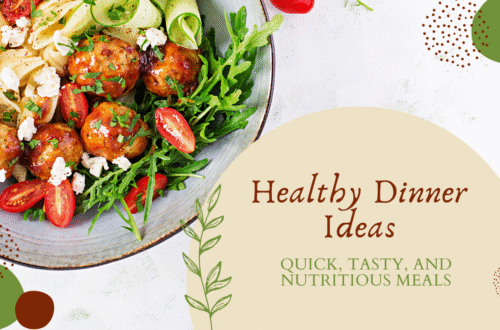Healthy meal ideas not only nourish your body but also make daily life easier, more organized, and sustainable. When you prioritize nutrient-rich foods, you’re giving your body the fuel it needs to thrive—boosting energy, enhancing immunity, supporting digestion, and promoting overall wellness. But the benefits go beyond nutrition. With proper planning, healthy meals save time, reduce food waste, and help you stick to your health goals more easily.
The foundation of any smart meal plan lies in balance. Focus on whole foods like fresh vegetables, seasonal fruits, lean proteins (such as chicken, beans, or fish), fiber-rich carbohydrates (like quinoa, sweet potatoes, or oats), and healthy fats (avocados, olive oil, nuts, and seeds). Including a variety of these components in your meals ensures you’re getting the essential nutrients your body needs to stay active, alert, and satisfied throughout the day.
If your goals include better weight management, improved digestion, or simply eating cleaner, incorporating healthy meal ideas into your routine can make a big impact. Planning meals ahead of time helps you avoid last-minute unhealthy choices, minimizes grocery store trips, and keeps your kitchen organized. You’ll also waste less food by using ingredients intentionally across multiple meals. Try prepping ingredients on the weekend, using themed dinner nights (like “Meatless Monday” or “Grain Bowl Friday”), and rotating favorite recipes to keep things exciting.
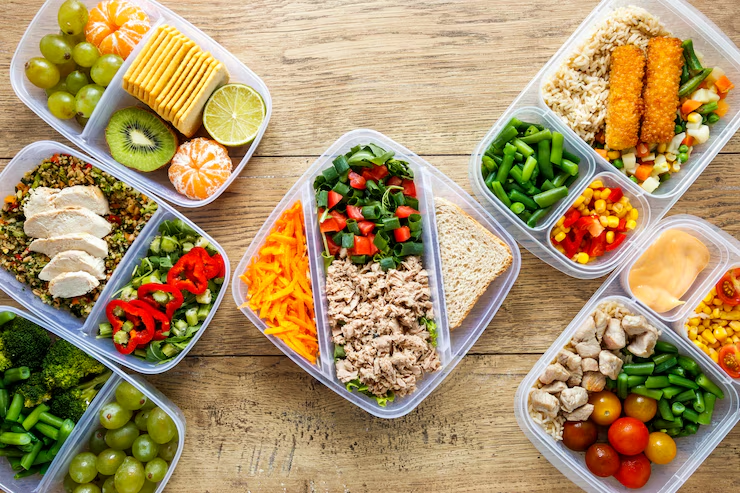
In the end, healthy eating is less about strict rules and more about building a sustainable habit. With the right ideas and structure, you can enjoy meals that taste great, feel good, and support your long-term well-being—one delicious plate at a time.
Tip 1: Build Balanced Meals with Protein, Produce, Whole Grains & Healthy Fats
Creating balanced meals is essential for maintaining energy, supporting your body’s functions, and promoting long-term health. A well-balanced plate should include four key components: lean protein, fresh produce, whole grains, and healthy fats. Protein—like chicken, fish, beans, tofu, or eggs—helps build muscle, supports metabolism, and keeps you feeling full. Pair this with a generous serving of colorful vegetables and fruits, which provide essential vitamins, minerals, and antioxidants.
Whole grains such as brown rice, quinoa, oats, or whole wheat bread add fiber and sustained energy to your meals. These complex carbohydrates break down slowly, helping to manage blood sugar levels and keep you satisfied longer. Don’t forget healthy fats—like avocados, nuts, seeds, or olive oil. These support brain health, hormone production, and the absorption of fat-soluble vitamins (A, D, E, and K), making them an important part of your daily nutrition.
By combining these four elements at each meal, you create a foundation for balanced eating that’s both nutritious and satisfying. Think grilled salmon with quinoa, roasted vegetables, and a drizzle of olive oil. Or try a veggie stir-fry with tofu, brown rice, and sesame seeds. With a little creativity and planning, building balanced meals becomes a simple and delicious part of your healthy lifestyle.
Tip 2: Embrace Plant-Based Staples: Legumes, Lentils, Grains & Veggies
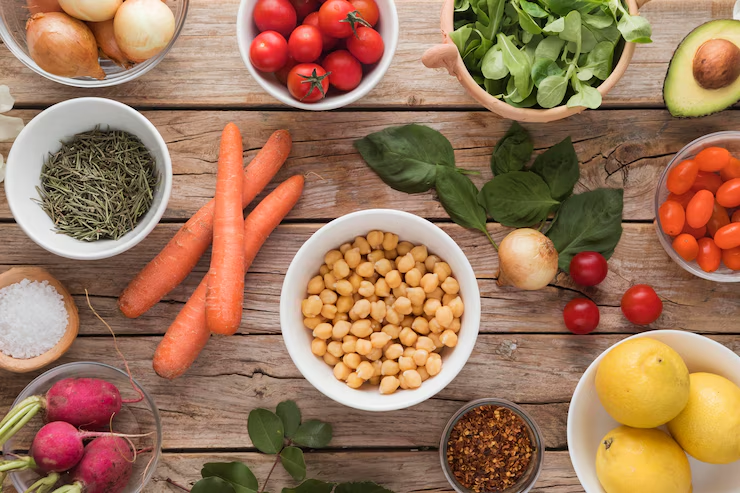
Meals built around plant-based staples like lentils, black beans, chickpeas, quinoa, and mixed vegetables are excellent healthy meal ideas—they’re nutrient-dense, rich in fiber and protein, and budget-friendly. Quinoa is a complete protein and high in essential minerals, making it a strong foundation for meals .
Imagine a comforting sweet potato–black bean chili, quinoa–chickpea salad, or lentil–spinach soup served with whole-grain bread. These dishes not only provide sustained fullness but also promote gut health. Sweet potatoes in chili add beta-carotene and fiber, while black beans supply resistant starch to support microbiome diversity.
Such healthy meal ideas help reduce inflammation, enhance satiety, and support digestive wellness. Incorporating varied legumes and whole grains ensures balanced amino acid profiles and nutrients like iron, folate, and antioxidants—ideal for overall well-being and long-term health
Tip 3: Quick, High-Protein Breakfast Options (Healthy Meal Ideas)
Start your morning with a healthy meal idea that’s both filling and blood‑sugar friendly: a no‑chop veggie frittata packed with cottage cheese, spinach, peppers, and eggs. This easy, five‑minute prep breakfast delivers about 19 g of protein per slice. Cottage cheese adds creaminess and slows digestion, helping prevent mid‑morning hunger .
The blend of protein and fiber-rich vegetables like spinach and peppers not only supports satiety but also provides essential vitamins A, C, and K, plus antioxidants . For balanced nutrition, pair it with a serving of fruit or a slice of whole‑grain toast to round out carbs and fiber—rounding out the plate with fruit adds vitamins and natural sweetness.
Tip 4: Batch-Cook and Meal Prep Smartly
Start your morning with a healthy meal idea that’s both filling and blood‑sugar friendly: a no‑chop veggie frittata packed with cottage cheese, spinach, peppers, and eggs. This easy, five‑minute prep breakfast delivers about 19 g of protein per slice. Cottage cheese adds creaminess and slows digestion, helping prevent mid‑morning hunger.
The blend of protein and fiber-rich vegetables like spinach and peppers not only supports satiety but also provides essential vitamins A, C, and K, plus antioxidants . For balanced nutrition, pair it with a serving of fruit or a slice of whole‑grain toast to round out carbs and fiber—rounding out the plate with fruit adds vitamins and natural sweetness
This healthy meal idea is ideal for meal-prep: bake once, slice, and enjoy during busy weekdays. The combination of protein, healthy fats, and fiber will fuel your day, support stable energy levels, and keep hunger at bay. Want customizable versions or full recipes? Just ask.
Tip 5: Use the 5-4-3-2-1 Shopping Method (Healthy Meal Ideas)
Adopt the 5‑4‑3‑2‑1 method as a simple grocery strategy: each week, choose 5 vegetables, 4 fruits, 3 protein sources, 2 spreads or sauces, and 1 grain. This structured approach streamlines shopping, encourages nutrient-rich choices, and helps avoid impulsive, less-healthy purchases—perfect for generating healthy meal ideas without overbuying
This framework fosters pantry balance and variety. By consciously selecting items across food groups, you gain flexible ingredients to create meals like veggie-packed stir-fries, hearty protein-grain bowls, or fruit-based desserts. It also supports waste reduction and mindful meal planning—core to sustainable healthy meal ideas .
The 5‑4‑3‑2‑1 method is adaptable—ideal for singles, couples, or families. Customize counts or add pantry staples like spices, oils, and dairy. The result? A weekly lineup of balanced, flavorful dishes without decision fatigue—your go-to framework for efficient, wholesome meal prep and inspiration..
Tip 6: Snack Strategically with Protein + Fibre (Healthy Meal Ideas)
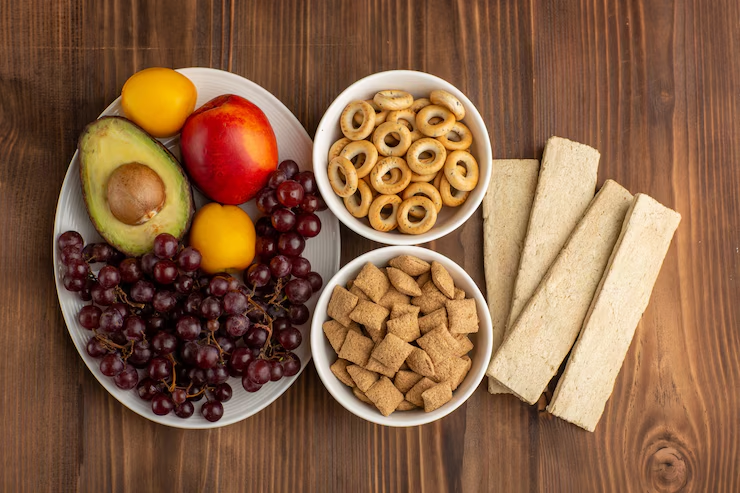
When low-energy cravings strike, skip sugary snacks that lead to crashes. Instead, choose healthy meal ideas like Greek yogurt mixed with berries and nuts—offering protein, fiber, antioxidants, and gut-supporting probiotics . This powerhouse combo stabilizes blood sugar and keeps you feeling full longer.
Other convenient, healthy meal ideas include roasted chickpeas, boiled eggs, or apple slices with peanut butter. Chickpeas are rich in protein and fiber for sustained energy , while a boiled egg delivers around 6 g of protein and essential nutrients. Pairing apple with nut butter blends sweet flavor with satisfying macronutrients.
By preparing snacks ahead—such as yogurt parfaits, roasted legumes, or nut mix—you redirect cravings to nourishing bites. Embracing these healthy meal ideas supports stable energy, reduces afternoon sluggishness, and keeps you on track with your wellness goals. Want more snack inspiration or recipes? Just ask!
Tip 7: Rotate Flavours and Theme Nights (Healthy Meal Ideas)
Introducing theme nights into your weekly meal plan—like Meat‑free Monday, Stir‑fry Friday, Salad Saturday—injects both structure and excitement into healthy meal ideas. This strategy simplifies decision-making, offering a reliable framework for planning while keeping your menu varied and engaging
Theme nights also encourage exploration of global cuisines and seasonal recipes without overwhelming your routine. For example, Taco Tuesday might spark interest in whole‑grain tortillas and lean protein, while Fish Friday could highlight heart‑healthy omega‑3s. Over time, rotating themes helps expand your culinary repertoire and discover favorite combos you’ll come back to .
Bringing the family onboard makes theme nights even more fun—kids can help pick or prepare meals, increasing engagement and reducing fatigue from repetitive menus. Plus, some themes lend themselves to batch cooking, creating leftovers for quick lunches the next day. It’s a simple yet effective way to refresh healthy meal ideas and maintain mealtime enthusiasm.
Tip 8: Prioritize Seasonal, Whole, and Minimally Processed Foods
Start by favoring fresh—or frozen—vegetables and fruits picked at their peak. These rainbow-colored staples deliver maximum nutrients and make it easy to build wholesome meals year-round. Stocking your fridge and freezer ensures you always have produce ready to go for healthy meal ideas.
Keep your pantry filled with staples like beans, oats, whole grains (quinoa, barley), and frozen produce. These versatile, budget-friendly ingredients form the backbone of wholesome cooking—think grain bowls, hearty soups, and filling breakfast porridges. They also support fiber-rich eating, a key pillar of healthy meal ideas.
Choose healthy oils such as extra‑virgin olive oil for cooking and dressings, and flavor meals with herbs, garlic, citrus, and spices. These simple additions boost both taste and nutrition while helping you reduce refined carbohydrates, excessive salt, and added sugars.
10 Healthy Meal Ideas to Inspire You (Healthy Meal Ideas)
Encouraging variety in your weekly menu is a core element of healthy meal ideas—think meals that transition smoothly from lunch to dinner and accommodate vegetarian to seafood preferences. Flexible options like grain bowls, veggie-loaded frittatas, and sheet-pan salmon empower you to mix flavors and nutrients without adding culinary stress
Grain bowls—like quinoa with chickpeas, roasted veggies, and fresh herbs—offer a customizable foundation that’s both satisfying and nutritious. Stuffed sweet potatoes topped with black beans or feta create a hearty vegetarian option that travels well from lunch to evening meals . For seafood lovers, quick dishes like salmon kebabs or spicy shrimp stir‑fry deliver protein and omega‑3 fats in under 30 minutes, making them excellent healthy meal ideas .
Sheet-pan dinners like balsamic chicken with asparagus or fish with roasted brussels sprouts are another go-to. They require minimal cleanup and combine lean protein with vegetables—ideal for busy nights. By rotating vegetarian, pescatarian, and lean‑protein meals, you ensure a colorful, balanced, and engaging meal plan
- Grilled Salmon with Quinoa & Kale Salad (Healthy Meal Ideas)
Rich in omega‑3s, fiber and vitamins. - Chicken Stir‑Fry with Vegetables & Brown Rice
Lean protein and colorful veggies over whole-grain base. - Sweet Potato & Black Bean Chili
Plant-based, filling, fiber-rich. - Lentil & Spinach Soup with Whole-Grain Bread (Healthy Meal Ideas)
Hearty and nutrient-dense. - Baked Tofu with Roasted Vegetables & Couscous
Flavorful and satisfying vegetarian fare. - Shrimp & Avocado Salad with Citrus Dressing
Light, refreshing with healthy fats. - Quinoa & Black Bean Bowl with Corn & Avocado (Healthy Meal Ideas)
A balanced vegan-friendly bowl rich in protein and fiber. - Cauliflower Rice Stir‑Fry with Veggies & Eggs
Low-carb base with protein and veggies. - Chicken Turkey Lettuce Wraps (Healthy Meal Ideas)
Lean, low-carb, easy to customize - Chia Seed Pudding with Berries
Great for breakfast or dessert: fiber, omega‑3s, antioxidants.
Building a Meal Plan You Can Stick To
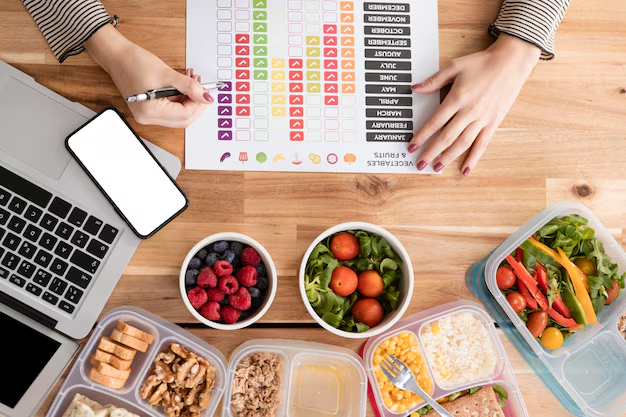
1. Start Small: Begin by planning a few meals or snacks per week before expanding. Gradual adoption makes it sustainable.
2. Organize Your Pantry: Group similar items and label; having essentials like grains, cans, nuts, and spices ready makes cooking easy.
3. Involve the Family: Ask others for their favorite meals and let kids pick one per week—they can even help prepare it. Increases engagement and variety.
4. Batch Cook & Freeze: Soups, casseroles, chilis, stews freeze well—cook extra and portion for future meals.
5. Theme Your Weeks: Assign food themes or cultural nights to ease decision-making and keep meals exciting.
Benefits of This Approach
- Nutrition‑packed meals that include fiber, protein, vitamins and healthy fats.
- Greater convenience: fewer last-minute unhealthy choices.
- Reduced stress and waste: planning ahead prevents impulsive buying and spoilage.
- Better portion control and variety, preventing dietary boredom.
Sample Weekly Schedule Example
| Day | Breakfast | Lunch | Snack | Dinner |
| Monday | Veggie frittata + fruit | Chickpea tuna salad | Greek yogurt + berries | Salmon with quinoa & kale |
| Tuesday | Chia pudding + almonds | Lentil soup with whole-grain toast | Apple slices + nuts | Tofu & roasted veggie couscous |
| Wednesday | Overnight oats with berries | Quinoa & black bean bowl | Roasted chickpeas | Chicken stir-fry with brown rice |
| Thursday | Smoothie + boiled egg | Leftover salad bowl | Hard-boiled egg | Shrimp avocado salad |
| Friday | Cottage cheese & fruit | Veggie wrap or lettuce wrap | Sliced veggies + hummus | Sweet potato & black bean chili |
| Saturday | Avocado chickpea toast | Leftover chili or soup | Nuts + fruit | Baked eggplant parmesan (light) |
| Sunday | Pancake made with oats | Mason jar salad + grilled chicken | Yogurt + granola | Cauliflower stir-fry with eggs |
Final Thoughts: Keep It Flexible & Enjoyable
Eating healthy doesn’t have to be boring or restrictive. The key is variety and balance. Focus on whole, unprocessed foods like colorful fruits, fresh vegetables, whole grains, legumes, lean proteins such as fish or chicken, and healthy fats like nuts, seeds, and olive oil. Rotating these ingredients throughout your meals keeps things interesting and ensures you’re getting a wide range of nutrients to support energy, immunity, and overall well-being.
One of the best ways to stick to healthy eating is by planning ahead. Meal prep can make a huge difference—try batch cooking once a week to prepare staples like grilled chicken, roasted veggies, or quinoa. Involve the whole family in selecting recipes and prepping ingredients to create a fun and motivating kitchen environment. You can also make mealtime more exciting by exploring new cuisines and flavors from around the world.
Simple planning tools like the 5‑4‑3‑2‑1 grocery rule (5 veggies, 4 fruits, 3 proteins, 2 whole grains, 1 healthy fat) help you shop smart. Try themed nights—like “Meatless Monday,” “Taco Tuesday,” or “Soup & Salad Friday”—to make your weekly menu easier to plan and more enjoyable to eat. With these easy, flexible ideas, healthy meals can become a delicious and sustainable part of your everyday routine.
FAQ
1. What constitutes a “healthy plate”?
A balanced plate includes half vegetables and fruits, one-quarter whole grains or starchy vegetables, and one-quarter lean protein, plus a small portion of healthy fats (e.g., olive oil, nuts). This format provides essential nutrients, satiety, and balanced energy.
2. How do I find healthy meal ideas using pantry staples?
Keep your pantry stocked with items like beans, oats, whole grains, and frozen produce. Pair these staples with fresh or frozen vegetables and healthy fats to create nourishing meals quickly—think grain bowls, soups, or overnight oats.
3. How can I maintain variety and avoid meal fatigue?
Use theme nights like Meat-free Monday or Stir‑fry Friday. This approach simplifies planning, encourages culinary exploration, and keeps meals interesting for the whole family.
4. What’s the difference between meal planning and meal prepping?
Meal planning involves deciding what to eat during the week. Meal prepping means preparing components—like chopping veggies or cooking grains—ahead of time. Both strategies streamline cooking and help maintain healthy habits.
5. How long can prepared meals stay fresh?
Cooked meals stored in airtight containers stay fresh in the fridge for about 3–4 days. Labeling them clearly helps manage consumption and prevent waste.
6. Do I need many recipes to start?
Not at all. Begin with your favorite meals and rotate them every 2–3 weeks. You don’t need extensive recipe books—just a few reliable go-tos work well.
7. Can small dietary changes be effective?
Yes—switching from refined to whole grains, adding more vegetables, or reducing sugar are simple but impactful changes. Small steps build sustainable healthy habits.
8. How can theme nights help plan meals?
Assigning themes to days (e.g., Meatless Monday, Stir-Fry Friday) reduces decision fatigue, encourages variety, and makes shopping and prepping easier.





